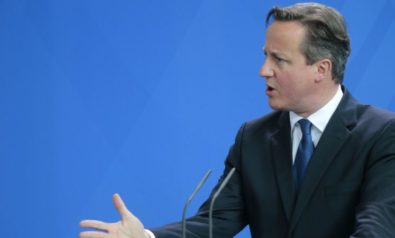How do radical political movements mask their racist rhetoric?
Let us depart from a truism: Modern politics relies enormously upon shaping “the message” toward targeted groups and constituencies. Whether it’s the Labour Party’s “Controls on Immigration” or the Tories’ “blue collar cabinet,” on either side of the recent 2015 General Election in Britain, reaching beyond a core “base” of activists is now widely recognized as the key ingredient to political success. This is no less true of the radical right in Europe and the United States since 1945, albeit manifested in a much different way.
The issue is ultimately a simple one. Radical right activists have long tended to be racist or xenophobic, sympathetic to fascism and anti-Semitic deceptions like Holocaust denial. In post-war Europe and the US, these are scarcely vote-winners, meaning that the transnational radical right has had to go much further in manipulating “the message” than mere political triangulation—something perhaps better described as “fifth column discourse,” a radical right rhetoric that is sanitized in order to challenge liberal democracy from within.
Verbal Judo
Exemplifying this is the one-time openly neo-Nazi Nick Griffin, the recently-deposed leader of the British National Party (BNP)—to date the United Kingdom’s most electorally successful far-right party. He called this embrace of euphemistic language “verbal judo” in April 1999, shortly before taking over leadership of the neo-fascist party: “Of course, we must teach the truth to the hardcore … when it comes to influencing the public, forget about racial differences, genetics, Zionism, historical revisionism and so on … It’s time to use the weight of democracy’s own myths and expectations against it by side-stepping and using verbal judo techniques.”
This separation between “hardcore” fascists and “the public” was influentially posited in Cas Mudde’s landmark study from 2000, The Ideology of the Extreme Right, claiming that such groups typically have a more “moderate ‘frontstage’” intended for public consumption and “a radical ‘back-stage’” targeted at neo-fascist activists.
Applying this formula to the BNP as a whole under his so-called modernizing leadership, Griffin’s understanding of “verbal judo” was made abundantly clear exactly a decade later. In April 2009, a leaked internal document in the lead-up to the European elections in May was circulated, using the perfectly Orwellian title “BNP Language and Concepts Discipline Manual.”
Quite simply, when the first of your 13 rules is we are “not a ‘racist’ or ‘racial’ party,” it probably means that you are. Some of the other “rules” are equally telling in terms of this turn toward a euphemism, one that is seductive in deploying the language of inclusion and democracy for exclusionary and illiberal ends. For these radical right ideologues and movements, in short, leopards have not changed their spots so much as finding better cover in the post-war era.
Politically Impossible
In 1945, the scale of defeat of the Axis powers—and with it any support for fascism in Europe and the US—made that ideology unacceptably toxic. While long associated with violence and militarism, fascism swiftly became synonymous with savagery and extermination in the European and American mind. And for good reason: Some 50 million dead in Europe, 6 million of them Jews, systematically murdered in the Third Reich’s specially-constructed death chambers.
Put simply, the “classic fascism” of Adolf Hitler and Benito Mussolini was so wholly discredited—and illegal in many places across Europe—so twinned with evil, that after World War II drawing upon that legacy was politically impossible. Some of the more intelligent members of the old guard realized that, at the very least, the outward trappings of fascism (the shirts and rallies, the overt anti-Semitism and revolutionary politics) needed to be consigned to sociopolitical oblivion.
Moving across the English Channel to France where, arguably, what became fascist ideology had been incubated by the likes of Georges Sorel or Charles Maurras’ Action Française before World War I, a new type of far-right politics emerged toward the end of the Cold War.
In keeping with this new shift of emphasis, in 1987 the leader of the Front National (FN), Jean-Marie Le Pen, notoriously declared: “I’m not saying the gas chambers didn’t exist. I haven’t seen them myself … I believe it’s just a detail in the history of World War Two.” He was convicted in France and, later, in Germany for these and similar remarks, which he reiterated earlier this year. This was classic dog-whistle politics for the “hardcore.”
One explanation for his reiteration of this Holocaust revisionism is that his daughter, Marine Le Pen, who now leads the party he founded in 1972, has moved in a still more publicly moderate direction, shifting her focus (as has been common among the “new far-right” over the last generation) away from anti-Semitism and toward anti-Muslim prejudice and immigration.
As a result, Jean-Marie Le Pen was indefinitely suspended from the FN at the hands of his daughter—whom he has disowned, and who now leads one of the largest political parties in contemporary France, boasting of 23 members of the European Parliament (MEP) since last year.
As a general modus operandi, ideological deception could apply to radical right rhetoric generally. As with “classic fascism,” so too with anti-Semitism. For instance, commenting on the German far-right scene in 2002, a report by the Office for the Protection of the Constitution maintained that hatred of Jews remained an “essential ideological ingredient of the far-right” in Germany, but with the following caveat: Although all relevant extreme right parties and factions work with anti-Semitic stereotypes, and anti-Jewish feeling is always present, no organization has hitherto placed the central focus of their propaganda on anti-Semitism. Recently, however, the use of anti-Semitic stereotypes has increased. Putative taboo-breakers could (unintentionally) break the “communication latency” down.
The New American Fascism
Let us now move across the Atlantic in order to consider a noxious pioneer of this communication latency, or what has been described above as front-stage euphemism and backstage extremism. It was by a man who famously declared in 1978 that “It is not necessary to wear brown shirts to be a fascist … it is not necessary to wear a swastika to be a fascist … It is not necessary to call oneself a fascist to be a fascist. It is simply necessary to be one!”
This forms the fitting frontispiece to the 1989 exposé of this man, aptly titled Lyndon LaRouche and the New American Fascism. In 2003, Helen Gilbert described Lyndon LaRouche in similar terms: “There’s something strange and cultish about LaRouche—but it’s hard to figure out exactly what he’s up to. Much of his message appears to be innocuous, kooky, contradictory, esoteric or shamelessly inflammatory. But underneath the weirdness lies a far-right world view … LaRouche’s brand of politics both employs standard elements of fascism and revisions that may initially throw some people off track.”
As with the contemporary radical right more generally, this rhetorical throwing “some people off track” best comes into focus by taking the long view. There are a few characteristics of the LaRouche movement that merit highlighting here, especially in relation to reheated (neo-)fascism and Holocaust revisionism.
A first excerpt is taken from LaRouche’s New Solidarity journal in 1973, which is an example of pretty unreconstructed fascism: “America must be cleansed for its righteous war by the immediate elimination of the Nazi Jewish Lobby and other British agents from the councils of government, industry, and labor.”
By 1978, a vital year for LaRouche of increased contact with Willis Carto—a notorious anti-Semite and founder of the misleadingly-named Institute for Historical Review (IHR)—the anti-Semitic language had become somewhat more subtle:
“Even on a relative scale, what the Nazis did to Jewish victims was mild compared with the virtual extermination of gypsies and the butchery of Communists. The point is that Adolf Hitler was put into power largely on the initiative of the Rothschilds, Warburgs and Oppenheimers, among other Jewish and non-Jewish financial interests centered in the City of London.
“… The ‘Holocaust’ simply proves that the failure of the Nuremberg tribunal to hang Hjalmar Schacht made the whole proceeding a travesty of justice. The murderers of the million and a half or more Jews who died in the “holocaust” are any group, Jewish or non-Jewish, which supported then or now the policies advocated by Felix Rohatyn or Milton Freidman. Either you, as a Jew, join with the U.S. Labor Party to stop Rohatyn, Friedman the Mont Pelerin Society now, or you are implicitly just as guilty of the death of millions of Jews as Adolf Hitler.”
The euphemistic techniques exemplified in this quotation are three-fold.
First, it attempts to deny central aspects of the Holocaust: to marginalize suffering, relativize guilt, question facts and shift blame away from the perpetrators of the Final Solution.
Second, it attempts to sanitize fascism by referring to one’s enemies as Nazis, fascists and so on (unless they join the LaRouche movement of course). Nazism’s crimes are thus both normalized and applied to perceived enemies.
Third, it uses individual Jews as anti-Semitic code: Reference to Rohatyn and Friedman, above, therefore, is a kind of metonymy for the Jewish people. In this way, anti-Semites deliberately disguise their attacks on Judaism by singling out “bad” Jews—wealthy or powerful individuals, political supporters of Zionism and, of course, anything relating to Israel (which is consistently portrayed in LaRouche propaganda as a neo-Nazi regime).
Doublespeak
As a result, actual fascist and Nazi actions—especially the Final Solution—are systematically trivialized. They return within the boundaries of normal human behavior. Additionally, enemies are vilified and demonized: They are the ones considered to be conspirators and mass murderers, embodiments of evil.
Thus, Zionists were the real Nazis and fascists, and combating them was the task for a new generation of radical right activists. For LaRouche, an evil oligarchy lies at the root of the world’s problems: It is this needing to be attacked by LaRouche’s devoted followers.
Fast-forward a few decades, a couple of handfuls of failed Democratic presidential nominations, a fraud conviction and LaRouche is still at it. For this radical right ideologue, the world is thus divided into two—the enemy, characterized as implacably evil (the British monarchy, American politicians and their Jewish agents)—and the putative saviors of humanity, namely, LaRouche and his followers. Major world events like 9/11 are consequently viewed through the prism of a global conspiracy.
From 2003, consider LaRouche’s “War, Hitler and Cheney”: “That new Reichstag Fire of which I warned in that January 2001 address, actually came, less than nine months later, on Sept. 11, 2001. Like Hitler’s Reichstag fire of 1933, the Sept. 11, 2001 attack was exploited by Vice President Dick Cheney and such followers of the Nazi-like Professor Leo Strauss as Attorney-General John Ashcroft, to unleash an attempted step-wise, fascist takeover of the U.S.A. from within.”
Among a number of “symbolic” Jewish targets, Strauss is accused by LaRouche of supporting Hitler’s rise to power, of having been involved in 9/11 and of promoting genocide in the Middle East. As LaRouche put it a year later, Leo Strauss was responsible for America “[m]arching down the road toward self-inflicted hell.”
This suggests that it is the British, the Jews and their supporters who stand accused of being fascists and Nazis. And, of course, of that age-old chestnut of being monopolistic conspirators. It is not merely that LaRouche uses special language and redefinitions to hide direct references to the Jews. He deploys Jewish “sounding” names or stereotypical Jewish references to convey his underlying message. There is also a proliferation of obvious epithets and codes such as “usurer,” “cabalist,” “Venetian,” “locust” or “Babylonian.”
This may puzzle the uninitiated, but it strikes an unmistakable chord with contemporary anti-Semites. One instance of many can be discerned from Stormfront.org in 2009, today’s leading radical right website: LaRouche is “advocating our cause by using politically correct terms so as not be labeled an anti-Jew.” Through innuendo and, in particular, metonymy, LaRouche propaganda returns to blaming Jews for every problem facing the world.
When it comes to LaRouche, a familiar response is that he is unhinged, or so eccentric as to be laughable. That may be true for those of unfamiliar with such doublespeak. Yet as with the radical right doublespeak as a whole, it misses the wood through the trees.
For the radical right will not simply show the same face, with the same jackboots and salutes and manifestos of old. They too know their history. Hopefully the wise words of Umberto Eco ago will serve as a warning for us, going forward for the next generation: “A new fascism, with its trail of intolerance, of abuse, and of servitude, can be born outside our country and imported into it, walking on tiptoe and calling itself by other names … It would be so much easier, for us, if there appeared on the world scene somebody saying, “I want to reopen Auschwitz, I want the Black Shirts to parade again in the Italian squares.”
Life is not that simple.
The views expressed in this article are the author’s own and do not necessarily reflect Fair Observer’s editorial policy.
Photo Credit: Frederic Legrand – COMEO / Everett Historical / S-F / Shutterstock.com
 We bring you perspectives from around the world. Help us to inform and educate. Your donation is tax-deductible. Join over 400 people to become a donor or you could choose to be a sponsor.
We bring you perspectives from around the world. Help us to inform and educate. Your donation is tax-deductible. Join over 400 people to become a donor or you could choose to be a sponsor.
Support Fair Observer
We rely on your support for our independence, diversity and quality.
For more than 10 years, Fair Observer has been free, fair and independent. No billionaire owns us, no advertisers control us. We are a reader-supported nonprofit. Unlike many other publications, we keep our content free for readers regardless of where they live or whether they can afford to pay. We have no paywalls and no ads.
In the post-truth era of fake news, echo chambers and filter bubbles, we publish a plurality of perspectives from around the world. Anyone can publish with us, but everyone goes through a rigorous editorial process. So, you get fact-checked, well-reasoned content instead of noise.
We publish 2,500+ voices from 90+ countries. We also conduct education and training programs
on subjects ranging from digital media and journalism to writing and critical thinking. This
doesn’t come cheap. Servers, editors, trainers and web developers cost
money.
Please consider supporting us on a regular basis as a recurring donor or a
sustaining member.
Will you support FO’s journalism?
We rely on your support for our independence, diversity and quality.





















Comment